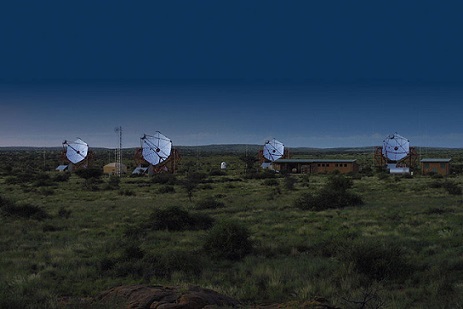
The four telescopes of the HESS telescope array in Namibia operating at night, H.E.S.S. Collaboration
The Leprince-Ringuet Laboratory (LLR) is a joint research unit (UMR 7638) of the National Institute of Nuclear Physics and Particle Physics (IN2P3) of the National Centre for Scientific Research (CNRS) and the Ecole Polytechnique. It is located on the site of the Ecole Polytechnique in Palaiseau (91).
From 1974 to 2001 it was known as the Laboratory of Nuclear Physics of High Energies (LPNHE-X).
This laboratory was founded in 1936 by Louis Leprince-Ringuet when he was appointed professor at the School, and is the oldest laboratory at the School.
The laboratory's research programme focuses on particle physics and astrophysics.
The particle physics experiments concern the study of the electroweak interaction (ALEPH, H1, CMS, T2K), CP symmetry violation (BaBar), and quark and gluon plasma (NA50, PHENIX). They take place at the accelerators of CERN (Geneva, Switzerland), DESY (Hamburg, Germany), SLAC (Stanford, California, USA), RHIC (Brookhaven, New York, USA), and JPARC (Tokai, Japan).
Since 1990, a programme of astrophysical, high-energy gamma-ray astronomy has been undertaken, first at Mount Whipple (Arizona, USA), then at the Themis site in the Pyrenees (CAT and CELESTE), and currently in Namibia (HESS) and in space (FERMI satellite).
These experiments require large and complex detectors, and are carried out in three phases: design and construction of the detector, then operation. The first two phases involve the use of significant technical resources in the mechanical, electronic and computer fields. The laboratory has a department in each of these fields. An administrative department ensures that everything runs smoothly.
